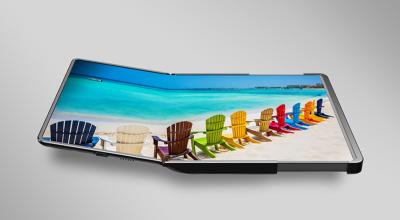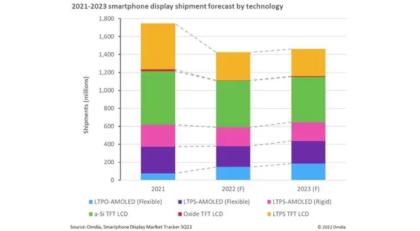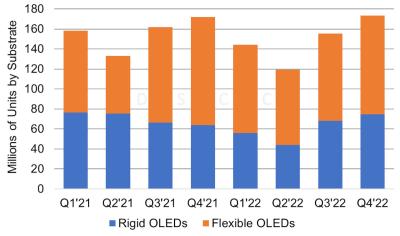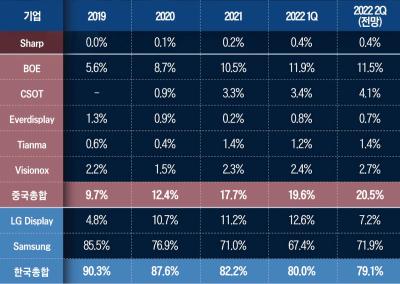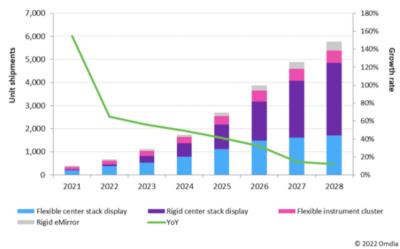OLED displays use organic materials that emit light when electricity is applied. OLEDs enable emissive, bright, thin, flexible and efficient displays - and so OLEDs are set to replace LCDs in all display applications - from small displays to large TV sets.
An AMOLED display is an OLED display that is driven by an active matrix backplane, it is a type of OLED display that can achieve high performance. Most OLED displays such as the ones used in TVs and smartphones are actually AMOLED displays.

What does AMOLED mean?
The term AMOLED means Active-Matrix OLED. The 'active-matrix' part refers to the driving electronics, or the TFT layer. When you display an image, you actually display it line by line (sequentially) as you can only change one line at a time. An AMOLED uses a TFT which contains a storage capacitor which maintains the line pixel states, and so enables large size (and large resolution) displays.
AMOLEDs today
AMOLED displays today are used in many applications - and are most common in smartphones. Most smartphones today use AMOLED displays - including the latest Samsung phones, all of Apple's iPhones models and more.
AMOLED displays are also used in OLED TVs, many wearables (such as the Apple Watch), tablets, laptops, VR headsets, monitors, and more.
AMOLED vs PMOLED
A PMOLED uses a simpler kind of driver electronics - without a storage capacitor. This means that each line is turned off when you move to the next line. So let's say you have 10 rows in your display - each row will only be on 1/10 of the time. The brightness of each row has to be 10 times the brightness you'd get in an AMOLED. So you use more voltage which shortens the lifetime of the OLED materials and also results in a less efficient display. So while PMOLEDs are cheaper to make than AMOLEDs they are limited in size and resolution (the largest PMOLED is only 5", and most of them are around 1" to 3"). Most PMOLEDs are used for character display, and not to show photos or videos.
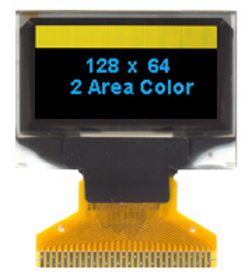
Flexible, foldable and rollable AMOLEDs
One of the main advantages of AMOLED displays is that they can be made flexible. Flexible AMOLEDs are already popular for many years in smartphones and wearables, and in 2019 we will experience the first foldable devices and rollable screens.
Looking to buy AMOLED displays?
Are you looking to buy AMOLED display for your project? AMOLEDs on the market range from small 1-inch ones for smartwatches through large OLEDs used in tablets and laptops - to large TV panels, up to 97" in size. Visit our OLED Marketplace, the world's most comprehensive OLED catalog, where you can browse the available panels, and let us help you find the best AMOLED supplier for your needs!
Further reading
The latest AMOLED news:
Omdia: the smartphone market is shrinking, but the LTPO-AMOLED display segment is growing fast
Market research firm Omdia says that the global smartphone market is shrinking, and is set to fall 18% in 2022 to 1.425 billion units. LTPS AMOLED display shipments will decline 19% compared to 2021 to 44 million units (LCDs will decline even faster at 26%).
The only segmented that Omdia says is growing is the LTPO AMOLED one, with a fast growth of 94% in 2022 (to 148 million units), and will continue to grow in 2023 (25%).
DisplayMate: the iPhone 14 Pro Max display breaks 15 display performance records
Our friends at DisplayMate posted an in-depth technical review of the iPhone 14 Pro Max display. The 6.7-inch 1290x2796 10Hz-120Hz 2,300 nits LTPO AMOLED receives DisplayMate's highest display performance grade of A+.

The new iPhone has the same display size and resolution as the earlier generation iPhone 13 Pro Max, but it includes several new enhances - such as a new always-on display mode, a new dynamic island centered around the sensor area at the top area, and a higher brightness of 2,300 nits vs 1,200 nits. Altogether, the iPhone 14 Pro Max sets 15 new display performance records.
LG Display: OLED will be the main display technology for future AR and VR devices
Yang Joon-Young, a VP at LG Display, says that recent improvement in OLED technologies will cause an industry shift from LCoS devices to OLED microdisplays in AR systems. LCoS will find a market in low-cost AR headsets, but most AR solutions will be based on OLEDs.
Next-generation VR systems, which will require higher pixel densities, will also switch from LCD and mobile AMOLED displays to OLED microdisplays that will offer pixel densities of over 3000 PPI.
BOE says its OLED production in Sichuan is limited due to power rationing, but no major impact
As Sichuan province in China suffers from a record heat wave, and the local authorities announces power rationing, limiting power supply to factories in the area.

BOE has two 6-Gen OLED production lines in Sichuan (the B7 line in Chengdu which started operation in 2017, and the line in Mianyang). The company says that it will have to "make adjustments" to its operations in both lines, but it does not expect any major impact on its operations.
Mini shows a new EV concept with a large round OLED display, to adopt it in future cars
British car maker Mini Cooper unveiled a new concept EV, called the Aceman, that features several new technologies such as a LED Matrix displays, an internal projector that shows designs on the dashboard, and more.
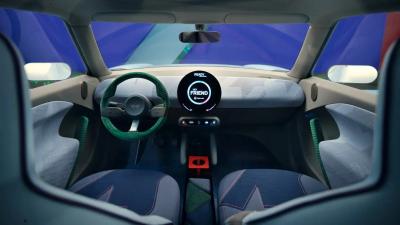
The Mini Aceman also includes a large round AMOLED display, which is the main (and only, it seems) display in the car. According to Mini, this same display will be used in future production EVs. Hopefully we will have more information on this new display soon.
Samsung develops a technology for AMOLED displays with multiple refresh rates
Samsung Display has developed a new technology that enables multiple refresh rates in AMOLED displays. The idea is that one can create several zones in the display, each with its own refresh rate.
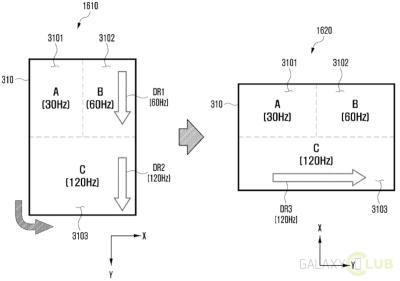
Driving at low refresh rates helps reduce the power consumption of the display and the new technology will be useful in scenarios in which a part of the screen needs high refresh rates (like video content embedded inside a web page).
DSCC sees a decline in smartphone OLED shipments and revenues in 2022
DSCC estimates that OLED smartphone display shipments will decrease 5% in 2022, to 592 million units. Flexible OLED shipments will rise by 2% (and will decline 10% in terms of revenues) but rigid OLED shipments will drop 14% (and revenues will decline 32%).
DSCC sees the OLED smartphone market declining 16% in 2022 to $317 billion (smartphone sales), and explains that this is due to macroeconomic headwinds, weakened consumer demand and problems with supply chains and inventories.
TCL shows a 17" foldable inkjet-printed IGZO AMOLED prototype
TCL's CSoT demonstrated a new prototype AMOLED display - a 17" IGZO foldable panel, that was produced using inkjet printing. The company says this kind of panel can be used in tablets, monitors and laptops.
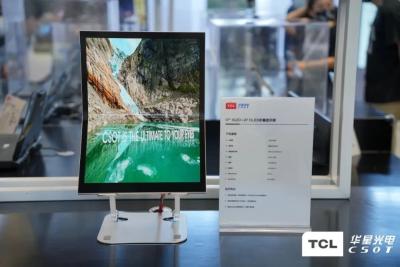
CSoT is progressing with its inkjet printing technology, and aims to start production in 2023. Last year the company demonstrated a 65" 8K inkjet-printed OLED TV panel, in addition to a 14" rollable panel.
Omdia: Chinese OLED makers increase their market share to over 20%
Omdia says that the market share of Korea's OLED producers, SDC and LGD is eroding, as Chinese OLED makers increase their OLED shipments. A main driver is Apple's increased iPhone AMOLED orders from BOE.
Omdia says that BOE's market share has increased from 5.6% in 2019 to almost 12% in 2022 (first quarter). The market share of all AMOLED makers in China is now above 20%, from from less than 10% in 2019.
Omdia sees almost 6 million OLED automotive panels shipped in 2028
Market research firm Omdia sees higher demand for OLED solutions for the automotive sector. Omdia says shipments of OLED panels will grow from around 500,000 units in 2022 to almost 6 million units by 2028.
Currently most automotive makers that use OLEDs adopt flexible panels, but Omdia actually sees the adoption of rigid glass-based OLEDs (single stack) growing faster than that of flexible OLEDs (tandem stack), and by 2027 the share of rigid automotive OLEDs will be higher than that of flexible ones. This is an interesting forecast.
Pagination
- Previous page
- Page 5
- Next page

